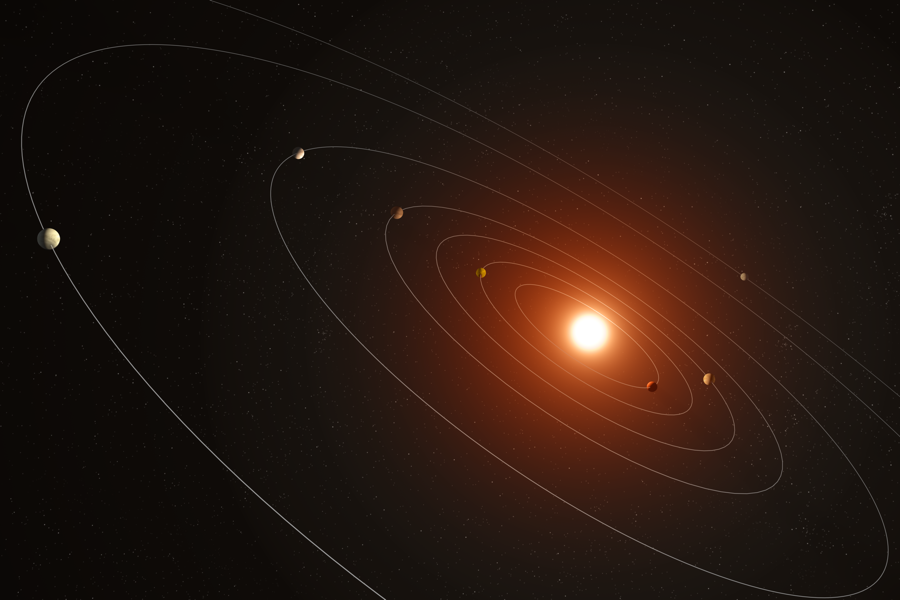- About▼
- Exo 101▼
- News
- Research▼
- Jobs + Internships▼
- Public Outreach▼
- Our Team▼
- Contact Us
- FR▼

A new study co-lead by a researcher at Bishop’s University has produced the most accurate analysis of exoplanets from NASA’s Kepler mission. The work has revealed Kepler-385 as a 7-planet, dynamically active exoplanet system and led to new insight into the architectures of exoplanet orbital properties.
A paper describing the new catalog has been accepted for publication in The Planetary Science Journal and available on arXiv.
A video and sonification of the orbital resonances of the Kepler-385 exoplanetary system. Credit: Bishop’s/J. Rowe.
Our revision to the Kepler Exoplanet catalogue provides the first true uniform analysis of exoplanet properties.”, said Jason Rowe, Canada Research Chair in Exoplanet Astrophysics, Professor at Bishop’s University in Quebec, Canada and iREx team member. “Improvements to all planetary and stellar properties has allowed us to conduct an in-depth study of the fundamental properties of exoplanetary systems to better understand exoplanets and directly compare these distant worlds to own Solar-System and to focus in on the details of individual systems such as Kepler-385.”
The first system with seven planets bathed in more radiant heat from their host star per area than any planet in our solar system has been revealed by continued study of data from NASA’s Kepler space telescope. Unlike any of our planetary neighbors, all seven planets in this system, named Kepler-385, are larger than Earth but smaller than Neptune. It is one of only a few planetary systems known to contain more than six verified planets or planet candidates. The Kepler-385 system is among the highlights of a new Kepler catalog that contains almost 4,400 planet candidates, including more than 700 multi-planet systems.
“We’ve assembled the most accurate list of Kepler planet candidates and their properties to date,” said Jack Lissauer, a research scientist at NASA’s Ames Research Center in California’s Silicon Valley and lead author on the paper presenting the new catalog. “NASA’s Kepler mission has discovered the majority of known exoplanets, and this new catalog will enable astronomers to learn more about their characteristics.”
At the center of the Kepler-385 system is a Sun-like star about 10% larger and 5% hotter than the Sun. The two inner planets, both slightly larger than Earth, are probably rocky and may have thin atmospheres. The other five planets are larger – each with a radius about twice the size of Earth’s – and expected to be enshrouded in thick atmospheres.
The ability to describe the properties of the Kepler-385 system in such detail is a testament to the quality of this latest catalog of exoplanets. While the Kepler mission’s final catalogs focused on producing lists optimized to measure how common planets are around other stars, this study focuses on producing a comprehensive list that provides accurate information about each of the systems, making discoveries like Kepler-385 possible.
This video orrery shows 1,791 candidate planets discovered transiting 709 different stars by NASA’s Kepler spacecraft. At the beginning, Kepler “object of interest” numbers show, to aid scientists in future studies. The number at the bottom-right counts Earth days. Most discovered planets have fast and compact orbits — our Solar System is included for the orbital scale. However, using 4 years of data and machine-learning analysis, some candidate planets have been found with periods longer than that of Mars. Other planets, which only transited once in the dataset, trace arcs only near the time they transited — they might have orbits like Jupiter, shown at the beginning for the planetary size scale. So that every planet can be seen, none are plotted smaller than 1.5 times Earth’s radius. Central stars are not shown; planets known about but not transiting, and transiting planets orbiting binary stars, are not represented. Credit: University of Chicago/D. Fabricky.
The analysis of the observed distribution of transit durations was led by Penn State Distinguished Professor of Astronomy and Astrophysics Eric Ford. Ford explained that transit durations are a powerful probe of the distribution of exoplanets; orbital eccentricities, which range from circular—an eccentricity equal to zero—to highly elongated. For most planets, there isn’t enough data to measure their orbital eccentricity on an individual basis. Ford’s research group developed methods to characterize the distribution of eccentricities for a population of transiting planets. Early attempts to characterize the shapes of planet’s orbits were limited by uncertainties in the properties of their host stars and approximations used to construct previous catalogs.
“While previous studies had inferred that small planets and systems with more transiting planets tend to have smaller orbital eccentricities, those results relied on complex models,” said Ford, who is a co-hire of the Penn State Institute for Computational and Data Sciences. “Our new result is a more direct and model-independent demonstration that systems with more transiting planets have more circular orbits.”
Most of the planets discovered by NASA’s Kepler mission are closer to their star than the Earth is to the Sun and expected to be too warm to be habitable. Only a small fraction of Kepler’s discoveries are in the “habitable zone”, the region where they could support liquid water on their surface—a concept introduced by Penn State Emeritus Evan Pugh Professor James Kastings. Nevertheless, the warm super-Earth’s provide intriguing clues about the climate of planets in the habitable zone.
The research team includes Jason F. Rowe at Bishops University in Canada, Jack Lissauer at NASA-Ames Research Center, Eric Ford and Kadri Nizam at Penn State, Daniel Jontof-Hutter at the University of the Pacific in California, Daniel C. Fabrycky at the University of Chicago, Darin Ragozzine at Brigham Young University, and Jason H. Steffen at the University of Nevada Las Vegas.
Bishop’s University Press Release
arXiv pre-print of the scientific paper
You must be logged in to post a comment.